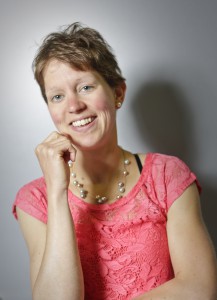Inside ERIBA: Mirjam Belderbos
How does ERIBA’s research evolve and who are the people behind it? The series “Inside ERIBA” gives you the opportunity to get to know the institute and the people that contribute to it. The second part in the series consists of an interview with ERIBA postdoc Mirjam Belderbos, who was recently awarded the KWF Bas Mulder Award.
Barcoding during the day, clinic duty at night
In ERIBA it is easy to forget that you’re actually in the research department of a hospital. The only white coats are lab coats and to most of the researchers, clinical applications of their research are something for a distant future. There are, of course, exceptions and one of them is ERIBA postdoc Mirjam Belderbos. She combines her fundamental research at ERIBA with a clinical residency in pediatrics. Her dream: to apply her research findings directly in the clinic.
After a Master’s degree in Medicine and a PhD in Immunology in Utrecht, Mirjam came to the UMCG in 2011 to become a pediatrician. This means an intensive training and long hours in the clinic, which she loved from the beginning. “However,” she explains, “I started to miss doing research almost immediately”. She found a solution to this problem by applying for a research grant, and getting it. That is how Mirjam came to work as a postdoc at ERIBA in the research group of Gerald de Haan.
Mirjam’s research at ERIBA is focused leukemic cells in mouse models. When leukemia is diagnosed, a patient has over billions of leukemic cells. Not all of these cells are the same; there are multiple “families” of cells sharing similar genetic and functional properties. These families are called clones. The number of clones in one patient, and the consequences for his/her disease are not yet known. The past years, Mirjam has worked to apply the cellular barcoding method, developed in ERIBA, on pediatric leukemia. With this method, it is possible to trace the output of individual cells. This allows Mirjam to follow different clones in time and study their behaviour. So, for Mirjam, the past few years consisted of barcoding during the day, and clinic duty at night.
Although the presence of multiple clones has been defined, their effect is still uncertain. Do all clones react similarly to treatment? Or is it necessary to adjust treatment to the presence of different clones? Recently, Mirjam was awarded the prestigious KWF Bas Mulder Award that will allow her to investigate these questions for four years. And she is hopeful to find answers: “Clinical studies indicate that relapsed leukemia often coincides with one clone surviving the treatment. The goal is to determine why this clone is resistant to treatment, in order to better predict, diagnose and prevent relapse in patients.
Although working in the clinic and doing fundamental research are quite different, Mirjam has found at least one recurring theme in both types of work. “It is crucial to be able to explain to a broad audience what you are doing. In the clinic this necessary because patients need to understand what is going on. But, in research this is an essential skill as well. People need to understand your research before they can take an interest in it.” No doubt this mindset has been an asset to Mirjam when writing research grant proposals. And this skill will remain important for her with the plans she has for the future. “I would like to keep doing translational research. This would allow me to treat a patient in the clinic, and discover novel insights in the treatment at the same time.” First things first, of course. We are glad to at least keep Mirjam for another four years at ERIBA.
Back to previous page






